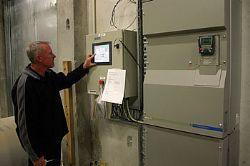WHEN an uncooperative variable speed drive posed a potentially disastrous commissioning delay for a new chiller project at a Marlborough vineyard, engineers opted to replace it with a Schneider Electric Altivar 71 drive, and made the deadline just in time. Based in Marlborough’s Awatere Valley, Yealand’s Winery Estate is one of New Zealand’s largest privately-owned vineyards. Production capacity is expanding progressively, and at the completion of the final phase in 2013, total capacity is expected to be around 10,400 tonnes of grapes. The latest expansion project (the first of three phases) saw the installation of scores of 50,000-litre stainless steel tanks for storing unfermented grape juice. The juice is initially chilled and then heated to initiate the fermentation process, and then chilled again. Chilling and heating services are provided by a single compressor driven by a 220kW electric motor, controlled by a variable speed drive. With harvest fast approaching, engineers were racing to complete the installation, but there was a major hiccup – the new variable speed drive, despite the best efforts of the supplier’s technician on site, could not adapt to the compressor motor load. The resulting oscillations in motor control led to a serious vibration throughout the motor and compressor. Project manager Peter Mann, from Christchurch’s Apollo Projects, says the oscillation issue created excessive vibration. “We tried everything to eliminate it and reduce the vibration – but we weren’t making any progress and with the harvest looming and the imminent arrival of thousands of litres of grape juice I knew I had to find a different solution, and called Schneider Electric.” Installation of the replacement drive took place over a weekend, and was coordinated by Rory Comer, general manager of Nelson’s Automation & Control Engineering Design. “Considering the time constraints, the changeover went remarkably smoothly. The drive was ordered on the Friday, and the compressor was running by Monday.” Schneider Electric also responded to the emergency by sending one of its drive gurus, Mark Appleman from the Engineered Services team, to the site to fine tune the drive. In addition to the Altivar 71 drive, says Comer, the installation comprised three of Schneider’s M340 PLCs and a large Prisma Plus switchboard – supplied by Christchurch’s TLJ Switchgear Ltd. “The major advantage of using equipment from a single supplier was easy communications – seamless connectivity via Modbus. “In the final analysis, I think the solution to the oscillation problem was the vAltivar’s flexibility – we were able to tune it very precisely to the load placed on the motor. We used the Power Suite tool (a Schneider Electric software package for programming drives, soft-starters and servo drives) – it’s very visual and simplifies programming. It makes things obvious and it’s great for fine tweaking,” says Comer. “That tweaking facility allowed us to eliminate the ‘hunting’ problem that plagued the initial installation – the constant under- and over-correcting – by finely adjusting the voltage to the motor at low frequencies.” Mann says getting the installation up and running so quickly was a huge relief, and he was impressed by the speed of Schneider Electric’s response. The other drive was returned to the supplier.
Schneider drive rescues winery
General
Sunday, 03 August 2008






